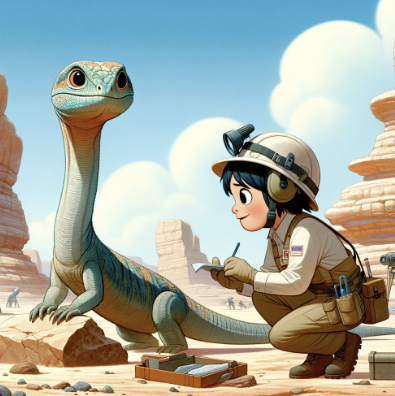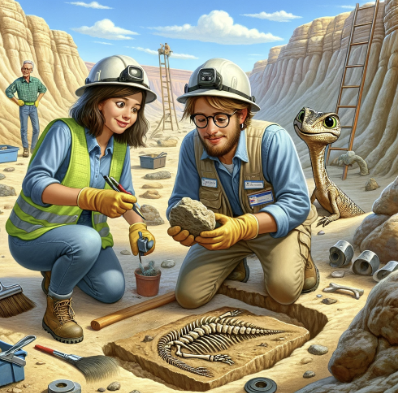So, James the long-necked lizard was off on another adventure. Under the bright and warming sun, James, the long-necked lizard, set out on a new adventure. The sun’s rays helped energize his cold-blooded body, allowing him to travel great distances with enthusiasm. Today, he was on his way to a geological dig site, where he hoped to learn more about the fascinating world beneath our feet.
As James arrived at the geological dig, he was welcomed by Chelsea Diggs, a passionate geologist who was leading the excavation. Chelsea had a friendly smile and a sparkle in her eye as she greeted her unique visitor.
James replied, “Hello, Chelsea! I’m James, and I’ve come to learn about what geologists do and why it’s important.”
The dig site was a treasure trove of rocks and minerals, each with its own unique personality. Chelsea eagerly began to show James the colorful world beneath their feet.
“Great to meet you Jame.” Chelsea said as she brushed dirt off her jeans. “Let’s talk rocks! Some rocks are sharp and jagged, like ancient swords carved by nature,” she explained, pointing to a cluster of rugged, pointed rocks. “Others are soft and smooth, as if they’ve been polished by time itself.”
Chelsea led James to a collection of rocks with a dazzling array of colors. “Look at these beauties,” she exclaimed. “Some rocks are vibrant reds and fiery oranges, while others are cool blues and soothing greens. It’s like a rainbow hidden in the Earth.”

As they continued exploring, Chelsea’s enthusiasm grew. “And let’s not forget about the minerals inside these rocks,” she said, her eyes lighting up. “These minerals give each rock its special characteristics. Some make the rocks sparkle like stars in the night sky, while others create swirls of patterns that look like ancient artwork.”
James couldn’t help but be mesmerized by the world of rocks and minerals that Chelsea was revealing to him. It was a colorful, fascinating world that sparked his imagination and left him eager to learn more.
Chelsea, delighted to share her knowledge with James, began explaining the roles of geologists:
“Geologists like me do many things,” Chelsea started. “First, we study the Earth’s structure and composition. That means we learn about rocks, minerals, and the layers of the Earth. By understanding what the Earth is made of, we can help find valuable resources like minerals and metals.”
“Second,” Chelsea continued, “we also play a crucial role in understanding and predicting natural disasters like earthquakes, volcanoes, and landslides. We study the Earth’s movements and help keep people safe by sharing important information.”

“Third,” Chelsea continued with excitement, “we’re like detectives of the past, searching for clues about Earth’s history by digging for fossils, just like we’re doing here. Fossils are the remains of ancient plants and animals that lived long ago, and they help us learn about life on Earth millions of years ago. We can even date fossils by studying the atoms they contain, which tells us how long ago those plants and animals lived.”
James, now even more intrigued, asked, “But Chelsea, how are fossils actually made?”
With a thoughtful expression, Chelsea replied, “That’s a great question, James! Fossils are formed when the remains of plants and animals are buried by layers of sediment, like mud or sand, over a very long time. As these layers pile up, they press down on the remains, and minerals from the sediment slowly replace the organic material, turning it into stone. It’s like creating a rock mold of what used to be a living creature. This process can take millions of years, which is why fossils are like snapshots of Earth’s ancient history.”
James was filled with awe as he watched the geologists carefully uncovering fossils from the ground. He realized that geology played a vital role in understanding our world and preserving its rich history.
With a newfound appreciation for the work of geologists and the importance of uncovering Earth’s secrets, James bid farewell to Chelsea and the dig site, eager to continue his journey of discovery and share his newfound knowledge with curious minds he would meet along the way.

